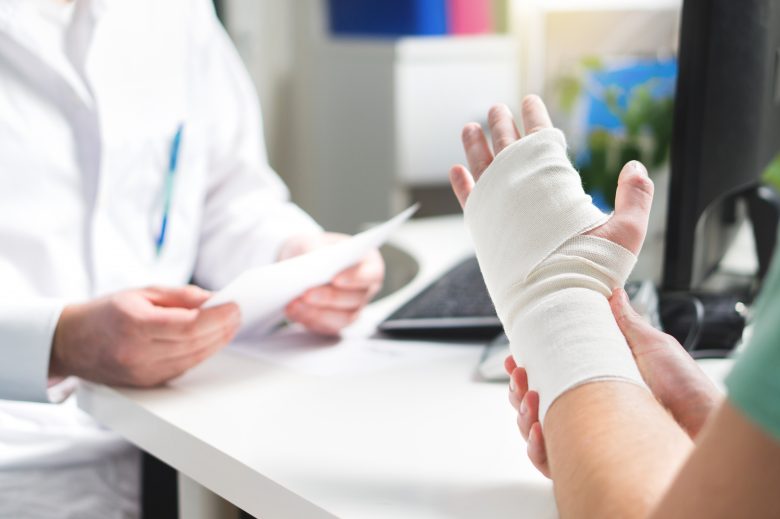Sprains and strains are among the most frequently occurring injuries across all major industries. A sprain occurs when a ligament is stretched or torn, whereas a strain is when a muscle or tendon is similarly stretched or torn. Both injuries can occur in an instant or develop slowly over time. Occupations with continuous physical tasks, including material handlers, truck drivers, nursing aides and orderlies, are at the highest risk and require robust prevention programs to reduce the frequency of injury.
Sprains and strains are obviously less severe than other musculoskeletal injuries (MSD) and never result in fatalities. As a result, they can often be overlooked in a company’s health and safety program. This is a mistake; if health and safety precautions are not taken and workers are not protected, sprains and strains can lead to many missed work hours and frustrate employees and employers alike. Additionally, recurring strains and sprains can lead to more serious injury over time.
All of this adds up to sprains and strains being a costly category of injury. Given their potential impact on your organization, here are three ways to reduce the number of sprains and strains in the workplace. Once you’ve taken basic steps like controlling or eliminating potential causes of sprains and strains, consider implementing these ideas to drive down the number of MSD incidents.
Educate and train workers on MSD hazards in the workplace
A great place to start sprain and strain reduction is to inform and train employees on potential MSD hazards present in your workplace. Begin by identifying and recording the risks that are specific to your workplace. MSD hazards exist whenever staff are performing repetitive, strenuous and/or prolonged physical tasks. For certain occupations and jobs, the risks may be fairly obvious, such as the heavy lifting and carrying tasks performed by material handlers. Be sure to keep a keen eye out for more subtle hazards as well; even office work can present risks if suitable controls are not introduced.
Be sure to include worker feedback when analyzing your workplace for potential hazards; they may be able to identify risks that management are unaware of. Once the MSD hazards are identified, record them in a document, along with recommended prevention strategies and appropriate training practices. It’s not enough to disseminate the document—you also need to train workers on how to recognize and adjust their work practices accordingly.
Sprain and strain toolbox talks
MSD training is often much more effective when it’s followed up with periodic toolbox talks or short safety meetings that specifically target sprains and strains. Toolbox talks are a useful tool to habitually reinforce safety ideas and prevention strategies to workers. Here are a few ideas to get the most out of sprain and strain toolbox talks:
- encourage worker participation by sharing real-life examples during the talks and ask staff members to share their relevant experiences,
- invest in supervisor communication training in both group and one-on-one settings.
- rotate topics or themes so that each talk is unique, even if they touch on common ideas and principles,
- prevent sprains by highlighting slip, trip and fall hazards present in your workplace (including ice and snow, clutter, ladders, uneven floors, and clutter in walkways), and
- prevent strains by talking about ergonomic best practices, offering lifting and carrying demonstrations, running warm-ups and stretching practices, and talking about avoiding awkward or twisting movements.
Other similar instructional strategies include performing both scheduled and unscheduled workplace walkthroughs and spot checks to evaluate if proper ergonomic techniques and other sprain and strain strategies are being practiced. This can provide a way for safety managers to offer more direct intervention when required.
Prevention-focused administrative controls
Certain administrative controls can improve working conditions and help reduce sprains and strains. These controls do not eliminate the hazard, but rather optimize operations to reduce worker exposure. Here are a few examples you can try in your workplace:
- Workplace design: Analyze the layout of your workplace and consider whether there are opportunities to redesign to improve workers’ safety. Can the distance employees have to travel be decreased? Look at your workplace through an ergonomic lens as well to see if improvements to workstations can be made.
- Hard labor rotation: If there is a specific task in the workplace that is harder and more taxing physically than others; schedule rotating short shifts to minimize prolonged worker exposure.
- Formal breaks: Implement and enforce scheduled breaks throughout the day to guard against workers over-exerting themselves. Promote stretch breaks and nutrition during these periods for maximum impact.
Evaluating and implementing these ideas in your workplace should be done with a supportive, positive spirit. When hazards are identified or improper practices are found, the response should focus on improvement and learning, and not be punitive or disciplinary. The key will be to get both workers and management to buy-in to reducing strains and sprains. But when that happens, taking these steps can have a major impact on the number of sprains and strains that happen at your company.

